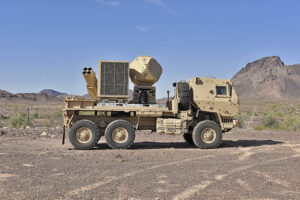
AUSA: In an intriguing hint of things to come, Raytheon has been given permission by the Pentagon to begin discussing how its Howler counter-drone system can work with the company’s Patriot batteries.
If you want to consider a use for such a combination, think of the Saudi Arabian oil production facilities struck by Iranian drones and cruise missiles — an attack that bypassed traditional Patriot missile defenses. “This would be a very capable system to be deployed with Patriot,” Cliff Johnson of Raytheon told me when I asked if deploying to Saudi would be a sensible use of the combination.
The Howler includes a Ku-band radar (KRFS) to detect targets, the Army-standard Forward Area Air Defense (FAAD) system for command and control, and the Coyote drone/missile to shoot down incoming drones. It’s a capability for which the Army issued a Joint Urgent Operational Need statement last year,

KRFS radar, part of Howler counter drone system
One of the weaknesses of Patriot in this day and age is that, while its radar can detect smaller threats such as drones, its missile is not designed to take out smaller targets flying slowly and at low altitudes. After all, those threats didn’t exist when Patriot’s requirements were drawn up. So the mission for Howler is area defense of critical targets, including other air and missile defense systems like Patriot, against low-and-slow threats. Howler’s C2 system could be based with the Patriot or separately.
As Breaking D readers will remember, the US is sending two more Patriot batteries to Saudi Arabia to improve protection against the Iranians (and their Houthi friends). In addition, 3,000 troops are on the way. We don’t know if any Howler systems will be following them, but it’s not an unreasonable assumption.
Bear in mind that Raytheon had earlier requested permission to discuss the combination of the two systems, and we don’t know if they received permission during AUSA as a coincidence or… But no one dissuaded me when I asked them if a Saudi or other CentCom deployment was likely.
Air Force awards SNC $13B contract for new ‘Doomsday’ plane
The win is a major victory for the firm in a competition that saw the surprise elimination of aerospace giant Boeing.



























